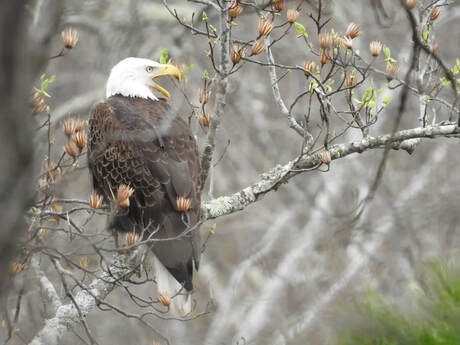 Bald eagle; Credit: Deanne Lawrence Bald eagle; Credit: Deanne Lawrence Sycamore Grove Farm, Madison County We infrequently see bald eagles (Haliaeetus leucocephalus) fly over our farm, which is such a treat. I occasionally pick up their calls on the Merlin bird ID app, as well. There are woods on the north side of our farm where, according to several long-time residents, eagles have nested on a regular basis, though we have never found a nest ourselves. The ones flying over our farm are probably heading for the Rapidan River, which is about one mile “as the bird flies” from our farm. We have seen eagles along the Rapidan looking for their favorite food: fish. Since the favorite food is fish, you will often see them near lakes, rivers and ponds. They will also go after other birds’ catch. In addition to fish, they eat waterfowl, turtles, rabbits, snakes and other small animals, as well as carrion. Eagles were once listed as an endangered species in the United States. Pesticide use and hunting played havoc with their ability to raise their young. The pesticide, DDT, interfered with their ability to produce strong eggshells – resulting in thin shells that often broke during incubation or failed to hatch. The lead in ammunition is still often ingested by eagles when they eat a deer carcass--shot by a hunter who either couldn’t reach the dead deer or only retrieved the head as a “souvenir"-- which can lead to lead poisoning in the birds. Bald eagles nest and live all year within Virginia. The Chesapeake Bay has the densest breeding population of bald eagles in the continental United States – only Alaska has more than we do. William & Mary’s The Center for Conservation Biology has been counting raptors for 30 years. They estimate that our bald eagle population is somewhere between 1,500 and 2,000 birds. Want to see bald eagles in Virginia? Here is a link to the six most likely state parks to spot bald eagles and some of the special events these parks offer related to eagles. In our area, you will frequently see eagles flying over and around the Blue Ridge Parkway. The bald eagle has been our national emblem since 1782. It has been revered by native peoples for far longer than that. Historians tell us that Benjamin Franklin was “rooting” for the American turkey to be our national emblem, not the bald eagle. Franklin was very disparaging in his correspondence, describing the bald eagle as “a Bird of bad moral Character. He does not get his living honestly [referring to the bird’s habit of stealing fish from other birds]…Besides he is a rank Coward”, referencing Franklin’s observation that a little bird could attack the eagle in defense of its nest and the eagle would leave. But the Second Continental Congress selected the bald eagle as the U.S. National Symbol on June 20, 1782. Immature eagles have a long “adolescence,” spending their first four years of life exploring different territories. Their wingspan of up to 7-1/2 feet at maturity allows them to fly hundreds of miles each day. Young birds born and tagged in Florida were found as far north as Michigan and birds from California have traveled to Alaska before settling down. Eagles have a much longer life span than many birds. Their life span in the wild ranges from 20-30 years. The oldest recorded bird in the wild was at least 38 years old. And they can be fascinating to watch. Bald eagles have been observed “playing” with objects such as plastic bottles and in one instance a witness recorded six bald eagles passing sticks to each other in midair. So here’s hoping we all see a few bald eagles this year! Happy birding! Charlene
0 Comments
Your comment will be posted after it is approved.
Leave a Reply. |
Have a blog or blog idea?
Let us know (click) Other Blogs
VA Native Plant Society - click Brenda Clement Jones - click John Muir Laws' Blog - click Megan's Nature Nook - click Categories
All
Archives
September 2023
Blog Administrator:
Kathleen A. VMN since 2018 |
